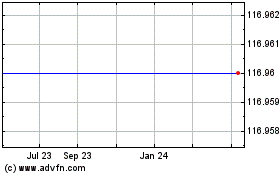U.S. Productivity Fell in Second Quarter
August 09 2016 - 9:20AM
Dow Jones News
WASHINGTON—U.S. worker productivity declined this spring for the
third straight quarter, extending a long stall in
labor-productivity growth that threatens to restrain worker pay and
the broader economy in the years ahead.
Nonfarm business productivity, measured as the output of goods
and services produced by American workers per hour worked,
decreased at a 0.5% seasonally adjusted annual rate in the second
quarter as hours increased faster than output, the Labor Department
said Tuesday.
Productivity had declined at a 0.6% pace in the first quarter,
unrevised from an earlier estimate, and dropped at a 2.4% pace in
the final three months of 2015.
Productivity in the second quarter was down 0.4% from a year
earlier, the first annual decline in three years.
Unit labor costs at nonfarm businesses rose at a 2.0% annual
rate in the spring after falling at a 0.2% pace in the first
quarter, which was revised down from a previous estimate of growth
at a 4.5% annual rate.
Compared with a year earlier, unit labor costs were up 2.1% in
the second quarter.
Economists surveyed by The Wall Street Journal had expected
productivity to rise at a 0.4% rate and unit labor costs to
increase at a 1.8% pace during the second quarter.
The pace of productivity growth is a key factor in determining
how quickly worker pay and overall economic output can grow over
time without stoking higher inflation. Strong productivity gains,
as seen in the late 1990s and early 2000s, can translate into
robust economic growth and rising inflation-adjusted wages. But
sluggish productivity growth can restrain wage and economic
growth.
Productivity growth started to slow before the 2007-2009
recession and has all but stalled in recent years. Annual growth
averaged 1.3% in 2007 through 2015, just half the average pace of
2.6% in 2000 through 2007, according to the Labor Department.
Federal Reserve Chairwoman Janet Yellen in June described the
outlook for productivity growth as a "key uncertainty for the U.S.
economy" that will help determine the future trend for living
standards.
"Understanding whether, and by how much, productivity growth
will pick up is a crucial part of the economic outlook," Ms. Yellen
said. "But this is a very difficult question, and economists are
divided. Some are relatively optimistic, pointing to the ongoing
pace of innovations that promise revolutionary technologies, from
genetically tailored medical therapies to self-driving cars. Others
believe that the low-hanging fruit of innovation largely has been
picked and that there is simply less scope for further gains."
She described herself as "cautiously optimistic" but said it
"would be helpful to adopt public policies designed to boost
productivity," such as promoting investment.
Business investment has been a notable sore spot for the economy
in recent months. A closely watched measure of business spending,
fixed nonresidential investment, has declined for the past three
quarters according to Commerce Department data. A proxy for
spending on new equipment, new orders for nondefense capital goods
excluding aircraft, has declined on a year-over-year basis almost
continuously for the past year and a half.
Some of the weakness has come from the mining industry. Capital
expenditures at Baker Hughes Inc. were down 19% in the second
quarter compared with the first quarter and plunged 73% from a year
earlier. The Houston-based oil-field-services firm and the broader
U.S. energy sector have been squeezed by a two-year slump in oil
prices.
"During this downturn, we have been extremely disciplined in our
capital deployment and going forward, we will continue to maintain
the same rigor," Chief Financial Officer Kimberly Ross told
analysts last month.
The outlook could be set to brighten. A recent Business
Roundtable survey of business executives found more U.S. firms
planned to ramp up their capital expenditures and fewer planned to
cut back on investment compared with earlier in 2016.
Defense contractor Raytheon Co. in late July reported its
operating margins improved in the second quarter, which Chief
Financial Officer Toby O'Brien told analysts was partly "the payoff
from our investment in factory automation and equipment
upgrades."
Sluggish productivity growth and rising labor costs could fuel
higher inflation if firms passed along higher expenses to customers
in the form of higher prices, though the precise relationship
between prices and wages remains ambiguous. Fed researchers last
year said they found little evidence of a link in recent years
between labor costs and price inflation. U.S. inflation has
undershot the Fed's 2% target for more than four years.
Write to Ben Leubsdorf at ben.leubsdorf@wsj.com and Josh
Mitchell at joshua.mitchell@wsj.com
(END) Dow Jones Newswires
August 09, 2016 09:05 ET (13:05 GMT)
Copyright (c) 2016 Dow Jones & Company, Inc.
Raytheon (NYSE:RTN)
Historical Stock Chart
From Mar 2024 to Apr 2024

Raytheon (NYSE:RTN)
Historical Stock Chart
From Apr 2023 to Apr 2024
